
The national flag of the Philippines is a horizontal bicolor flag with equal bands of royal blue and crimson red, with a white, equilateral triangle at the hoist. In the center of the triangle is a golden-yellow sun with eight primary rays, to represent the original eight provinces that rebelled against the Spanish during the 1896 Philippine Revolution. At each vertex of the triangle is a five-pointed, golden-yellow star, each of which representing one of the country's three main island groups—Luzon, Visayas, and Mindanao. The white triangle at the hoist represents liberty, equality, and fraternity. A unique feature of this flag is its usage to indicate a state of war if it is displayed with the red side on top, which is effectively achieved by flipping the flag upside-down.

The national flag of the Russian Federation is a tricolour of three equal horizontal bands: white on the top, blue in the middle, and red on the bottom.

The National Emblem of the People's Republic of China is a national symbol of the People's Republic of China and contains in a red circle a representation of Tiananmen Gate, the entrance gate to the Forbidden City, where Mao Zedong declared the foundation of the People's Republic of China (PRC) in 1949. Above this representation are the five stars found on the national flag. The largest star represents the Chinese Communist Party (CCP), while the four smaller stars represent the four revolutionary social classes as defined in Maoism. The emblem is described as being "composed of patterns of the national flag":
...The red color of the flag symbolizes revolution and the yellow color of the stars the golden brilliant rays radiating from the vast red land. The design of four smaller stars surrounding a bigger one signifies the unity of the Chinese people under the leadership of the Communist Party of China (CPC).
—China Yearbook 2004

Ust-Orda Buryat Okrug, or Ust-Orda Buryatia, is an administrative division of Irkutsk Oblast, Russia. It was a federal subject of Russia from 1993 to January 1, 2008, when it merged with Irkutsk Oblast. It also had autonomous okrug status from September 26, 1937 to 1993. Prior to the merger, it was called Ust-Orda Buryat Autonomous Okrug. It is one of the two Buryat okrugs in Russia, the other one is Agin-Buryat Okrug in Zabaykalsky Krai.

The Assyrian flag is the flag widely used to represent the Assyrian nation in the homeland and in the diaspora.
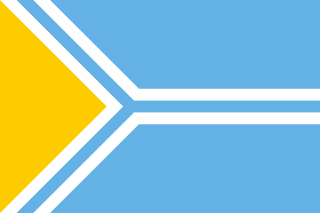
The flag of Tuva, a republic in the Russian Federation, is a light blue field with a white-fimbriated pall of the same color bordering a yellow triangle on the hoist.
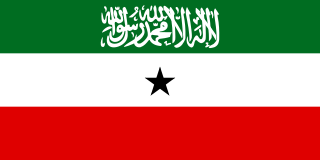
The flag of Somaliland was adopted on 14 October 1996. It consists of a tricolour of green, white, and red, with a black star located in the centre. On the green stripe, there is the Shahada in white calligraphic script.
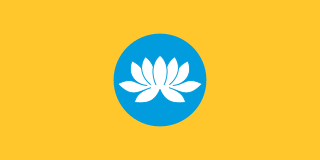
The flag of Kalmykia consists of a yellow field with a sky blue circle in the center containing a lotus. The yellow stands for the sun, the people and the religious faith of the nation. The blue represents the sky, eternity, and steadiness. The lotus is a symbol of purity, spiritual rebirth and happiness. Its five upper petals represent the continents and the lower four stand for the quarters of the globe. Together, they symbolize the will of the Kalmyks to live in friendship and to cooperate with all the nations of the world.

The flag of the Republic of Sakha (Yakutia) (Yakut: Саха Өрөспүүбүлүкэтин былааҕа Saqa Öröspüübülüketin Bılaağa; Russian: Флаг Республики Саха (Якутия)), in the Russian Federation, is one of the official symbols of the Sakha Republic, alongside the coat of arms and the national anthem of the Sakha Republic. The flag has four horizontal stripes. From top to bottom, the stripes are light blue (3/4 of the flag's width), white (1/16), red (1/16), and green (1/8). The flag has been used officially as the flag of the Sakha Republic since 14 October 1992. The light blue stripe is charged with a white disc in the center. The diameter of the disc is 2/5 of the flag's width.
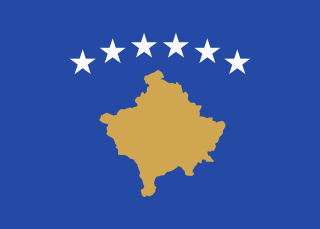
The flag of the Republic of Kosovo was adopted by the Assembly of the Republic of Kosovo immediately following the unilateral declaration of independence of Kosovo on 17 February 2008. The flag design emerged from an international competition, organized by an informal group from the Provisional Institutions of Self-Government known as the Kosovo Unity Team, which attracted almost one thousand entries. The winning design was proposed by Muhamer Ibrahimi. It shows six white stars in an arc above a golden map of Kosovo, all on a blue field. The stars symbolize Kosovo's six major ethnic groups: Albanians, Serbs, Bosniaks, Turks, Romani, and Gorani.

Ust-Orda Buryat Autonomous Okrug was an autonomous okrug of Russia within Irkutsk Oblast. After a 16 April 2006 referendum, in which almost 90% of participants voted for unification with Irkutsk Oblast, the autonomous okrug was merged into the oblast on 1 January 2008. The territory has since been administrated as the Ust-Orda Buryat Okrug of Irkutsk Oblast.

The flag of Chukotka Autonomous Okrug is a blue field charged with a white triangle at the hoist side. At the center of the triangle is a roundel of the Russian national flag rimmed with a thick yellow border.

The national flag of the People's Republic of China, also known as the Five-star Red Flag, is a Chinese red field with five golden stars charged at the canton. The design features one large star, with four smaller stars in an arc set off towards the fly. It has been the national flag of China since the foundation of the People's Republic of China on 1 October 1949. The flag was designed by Zeng Liansong.

Bokhansky District is an administrative district of Ust-Orda Buryat Okrug of Irkutsk Oblast, Russia, one of the thirty-three in the oblast. Municipally, it is incorporated as Bokhansky Municipal District. It is located in the south of the oblast. The area of the district is 3,700 square kilometers (1,400 sq mi). Its administrative center is the rural locality of Bokhan. Population: 25,398 (2010 Russian census); 26,897 ; 26,722 (1989 Soviet census). The population of Bokhan accounts for 20.4% of the district's total population.

Alarsky District is an administrative district of Ust-Orda Buryat Okrug of Irkutsk Oblast, Russia, one of the thirty-three in the oblast. Municipally, it is incorporated as Alarsky Municipal District. It is located in the south of the oblast. The area of the district is 2,700 square kilometers (1,000 sq mi). Its administrative center is the rural locality of Kutulik. As of the 2010 Census, the total population of the district was 21,479, with the population of Kutulik accounting for 22.7% of that number.
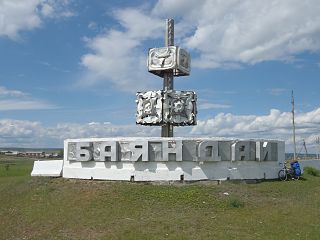
Bayandayevsky District is an administrative district of Ust-Orda Buryat Okrug of Irkutsk Oblast, Russia, one of the thirty-three in the oblast. Municipally, it is incorporated as Bayandayevsky Municipal District. It is located in the south of the oblast. The area of the district is 3,756.2 square kilometers (1,450.3 sq mi). Its administrative center is the rural locality of Bayanday. Population: 11,529 (2010 Russian census); 13,730 ; 14,808 (1989 Soviet census). The population of Bayanday accounts for 23.2% of the district's total population.

Ekhirit-Bulagatsky District is an administrative district of Ust-Orda Buryat Okrug of Irkutsk Oblast, Russia, one of the thirty-three in the oblast. Municipally, it is incorporated as Ekhirit-Bulagatsky Municipal District. It is located in the south of the oblast. The area of the district is 5,200 square kilometers (2,000 sq mi). Its administrative center is the rural locality of Ust-Ordynsky. As of the 2010 Census, the total population of the district was 30,597, with the population of Ust-Ordynsky accounting for 48.7% of that number.

Nukutsky District is an administrative district of Ust-Orda Buryat Okrug of Irkutsk Oblast, Russia, one of the thirty-three in the oblast. Municipally, it is incorporated as Nukutsky Municipal District. It is located in the south of the oblast. The area of the district is 2,400 square kilometers (930 sq mi). Its administrative center is the rural locality of Novonukutsky. Population: 15,743 (2010 Russian census); 17,209 ; 17,110 (1989 Soviet census). The population of Novo-Nukutsky accounts for 21.8% of the district's total population.

Osinsky District is an administrative district of Ust-Orda Buryat Okrug of Irkutsk Oblast, Russia, one of the thirty-three in the oblast. Municipally, it is incorporated as Osinsky Municipal District. It is located in the south of the oblast. The area of the district is 4,400 square kilometers (1,700 sq mi). Its administrative center is the rural locality of Osa. Population: 20,431 (2010 Russian census); 20,962 ; 20,668 (1989 Soviet census). The population of Osa accounts for 22.1% of the district's total population.

Osa is a rural locality and the administrative center of Osinsky District of Ust-Orda Buryat Okrug, Irkutsk Oblast, Russia. Population: 4,523 (2010 Russian census); 4,486 (2002 Census);



















